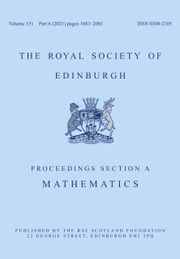Research Article
RETRACTED - Compact reduction in Lipschitz-free spaces
- Part of:
-
- Published online by Cambridge University Press:
- 08 December 2021, pp. 1683-1699
-
- Article
- Export citation
Asymptotically autonomous robustness of random attractors for a class of weakly dissipative stochastic wave equations on unbounded domains
- Part of:
-
- Published online by Cambridge University Press:
- 05 November 2020, pp. 1700-1730
-
- Article
- Export citation
A generalized skein relation for Khovanov homology and a categorification of the θ-invariant
-
- Published online by Cambridge University Press:
- 05 November 2020, pp. 1731-1757
-
- Article
- Export citation
A short proof that ℬ(L1) is not amenable
- Part of:
-
- Published online by Cambridge University Press:
- 06 November 2020, pp. 1758-1767
-
- Article
- Export citation
The Fourier extension operator of distributions in Sobolev spaces of the sphere and the Helmholtz equation
- Part of:
-
- Published online by Cambridge University Press:
- 16 November 2020, pp. 1768-1789
-
- Article
- Export citation
Compact groups in which all elements have countable right Engel sinks
- Part of:
-
- Published online by Cambridge University Press:
- 13 November 2020, pp. 1790-1814
-
- Article
- Export citation
Two-phase Stokes flow by capillarity in full 2D space: an approach via hydrodynamic potentials
- Part of:
-
- Published online by Cambridge University Press:
- 02 December 2020, pp. 1815-1845
-
- Article
-
- You have access
- Open access
- Export citation
A new classification on parallel Ricci tensor for real hypersurfaces in the complex quadric
- Part of:
-
- Published online by Cambridge University Press:
- 18 November 2020, pp. 1846-1868
-
- Article
- Export citation
On regularity properties of a surface growth model
- Part of:
-
- Published online by Cambridge University Press:
- 09 March 2021, pp. 1869-1892
-
- Article
- Export citation
The identity G(D)f = F for a linear partial differential operator G(D). Lusin type and structure results in the non-integrable case
- Part of:
-
- Published online by Cambridge University Press:
- 26 November 2020, pp. 1893-1919
-
- Article
- Export citation
Borderline gradient estimates at the boundary in Carnot groups
- Part of:
-
- Published online by Cambridge University Press:
- 02 December 2020, pp. 1920-1953
-
- Article
- Export citation
Regularity criterion on the energy conservation for the compressible Navier–Stokes equations
- Part of:
-
- Published online by Cambridge University Press:
- 11 December 2020, pp. 1954-1971
-
- Article
- Export citation
The convergence rate of the fast signal diffusion limit for a Keller–Segel–Stokes system with large initial data
- Part of:
-
- Published online by Cambridge University Press:
- 23 December 2020, pp. 1972-2012
-
- Article
- Export citation
Topological complexity of real Grassmannians
- Part of:
-
- Published online by Cambridge University Press:
- 12 January 2021, pp. 2013-2029
-
- Article
- Export citation
Large deviations for a class of tempered subordinators and their inverse processes
- Part of:
-
- Published online by Cambridge University Press:
- 08 January 2021, pp. 2030-2050
-
- Article
- Export citation
Hausdorff measure and Assouad dimension of generic self-conformal IFS on the line
- Part of:
-
- Published online by Cambridge University Press:
- 15 December 2020, pp. 2051-2081
-
- Article
- Export citation
Retraction
Compact reduction in Lipschitz-free spaces - RETRACTION
-
- Published online by Cambridge University Press:
- 01 February 2022, p. 2082
-
- Article
-
- You have access
- Export citation
Front Cover (OFC, IFC) and matter
PRM volume 151 issue 6 Cover and Front matter
-
- Published online by Cambridge University Press:
- 08 December 2021, pp. f1-f2
-
- Article
-
- You have access
- Export citation
Back Cover (IBC, OBC) and matter
PRM volume 151 issue 6 Cover and Back matter
-
- Published online by Cambridge University Press:
- 08 December 2021, pp. b1-b2
-
- Article
-
- You have access
- Export citation





















